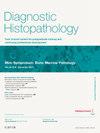原发性皮肤神经内分泌肿瘤:概念的理解与鉴别诊断的探讨
引用次数: 0
摘要
伴有神经内分泌分化的皮肤肿瘤并不罕见。许多这些肿瘤具有相似的临床,细胞学和免疫组织化学特征,使最终诊断具有挑战性。此外,一些皮肤肿瘤可能很少表现出神经内分泌标志物的异常表达,而这些肿瘤中真正的神经内分泌分化仍然存在争议。一些实体的命名和分类也令人困惑,反映了组织学解释的困难,以及一些肿瘤的罕见性,以及对其发病机制的不断发展的理解。例如,低级别的皮肤神经内分泌癌已被重新命名为具有神经内分泌分化的汗腺癌,表明可能起源于汗腺。另一个例子是多形性汗腺癌,其存在与否一直存在争议。在本文中,我们回顾了基本的组织学定义,讨论了当接近神经内分泌肿瘤的鉴别诊断时结合临床病理结果和免疫组织化学解释。我们还回顾了最近描述的实体及其在文献中的演变。本文章由计算机程序翻译,如有差异,请以英文原文为准。
Primary cutaneous neuroendocrine neoplasms: understanding concepts and approaching the differential diagnosis
Cutaneous tumours with neuroendocrine differentiation are not uncommon. Many of these tumours share similar clinical, cytological and immunohistochemical features rendering the final diagnosis challenging. Furthermore, some cutaneous tumours may rarely show aberrant expression of neuroendocrine markers, while true neuroendocrine differentiation in these remains debatable. Nomenclature and classification of some entities have also been confusing, reflecting the difficulty in histological interpretation as well as rarity of some of the tumours described, and the evolving understanding of their pathogenesis. For instance, low-grade neuroendocrine carcinoma of the skin has been re-named to sweat gland carcinoma with neuroendocrine differentiation, indicating a likely sweat gland origin. Another example is polymorphous sweat gland carcinoma, of which existence has been debated. In this article, we review the basic histological definitions, discuss incorporating clinicopathological findings and immunohistochemical interpretation when approaching the differential diagnoses of neuroendocrine tumours. We also review the most recently described entities and their evolution in the literature.
求助全文
通过发布文献求助,成功后即可免费获取论文全文。
去求助
来源期刊

Diagnostic Histopathology
Medicine-Pathology and Forensic Medicine
CiteScore
1.30
自引率
0.00%
发文量
64
期刊介绍:
This monthly review journal aims to provide the practising diagnostic pathologist and trainee pathologist with up-to-date reviews on histopathology and cytology and related technical advances. Each issue contains invited articles on a variety of topics from experts in the field and includes a mini-symposium exploring one subject in greater depth. Articles consist of system-based, disease-based reviews and advances in technology. They update the readers on day-to-day diagnostic work and keep them informed of important new developments. An additional feature is the short section devoted to hypotheses; these have been refereed. There is also a correspondence section.
 求助内容:
求助内容: 应助结果提醒方式:
应助结果提醒方式:


